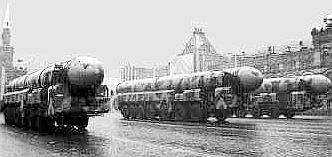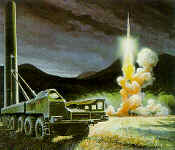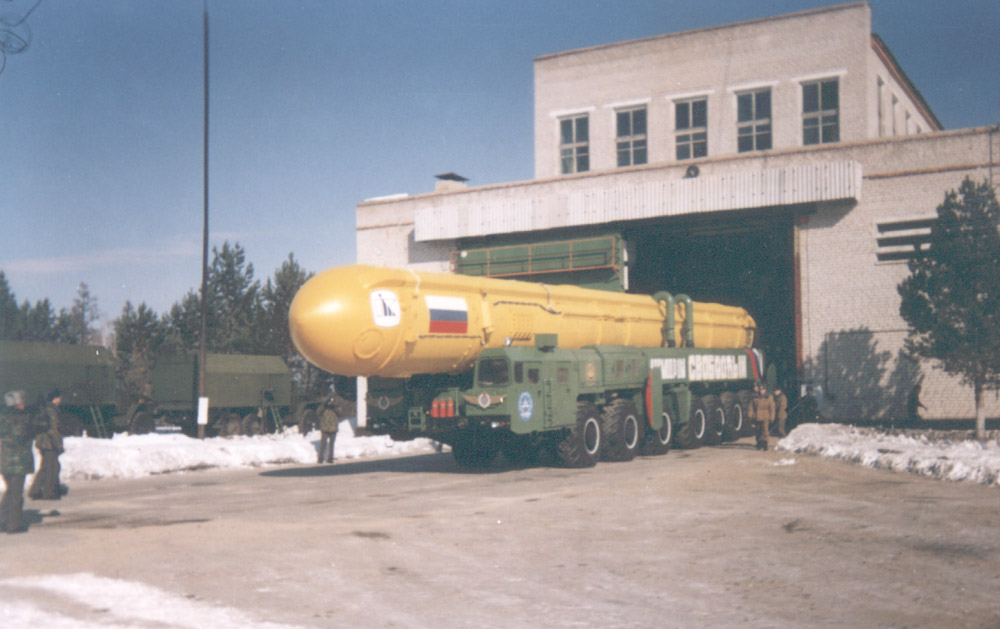Converting Military Intercontinental Ballistic Missiles to Peaceful Space Launchers
 |
The converted SS-25s have had some successes and some failures as space boosters.
SS-25s are built in Russia by a state-owned enterprise known as Votkinsky Zavod. The Votkinsk Plant State Production Association is one of the foremost missile production facilities in Russia. It has built SS-20, SS-23 and SS-25 ballistic missiles.
Consumer Goods and the ICBM
Missile components are produced alongside civil and consumer goods at a main plant in downtown Votkinsk and the final flight-ready missiles are assembled at a plant seven miles outside of town. An American inspection team monitors military production.
 |
Used as a weapon, an SS-25 carries a single nuclear warhead atop a three stage rocket system, and is about the size of a U.S. Minuteman ICBM.
Operational since 1985, the SS-25 ICBM is a road-mobile weapon that can fire from sites in the field or through the sliding roof of a garage it occupies at its base.
Under the START-II Treaty, Russia is permitted to place these ICBMs in refurbished missile silos.
The breakup of the old Soviet Union had a significant impact on the SS-25 (Topol) program. The nation of Belarus manufactured the missile transporter launchers while 90 percent of the guidance system was manufactured in Ukraine.
The Start-1 Rocket
A version of the space launcher known as Start-1, converted from the SS-25, had three successful flights to orbit in the 1990s:
- The 573-lb. Russian experimental communications satellite EKA-1 was launched from launch complex 158 at Plesetsk Cosmodrome to a 425- by 600-mi.-high orbit on March 25, 1993.
- The Zeya-1 communications satellite was launched to a 285-mi.-high orbit for the Ministry of Defense of the Russian Federation on March 4, 1997, from launch complex 5 at the Svobodny Cosmodrome.
- The Early Bird civilian earth resources and photo-imaging satellite was launched from the Svobodniy Cosmodrome to a 300-mi.-high orbit on December 24, 1997, for the U.S. agency EarthWatch of Longmont, Colorado. The satellite was manufactured by Orbital Sciences Corp., McLean, Virginia,
 |
The Zeya satellite, used for navigation and geodesy tests from a sun-synchronous orbit, was the payload for the first-ever launch from Russia's Svobodniy Cosmodrome. Also known as Mozhaets, the satellite was designed by students of the Mozhaiskiy military space engineering academy and built at NPO Prikladnoi Mekhaniki at Zhelenogorsk.
The Start Rocket
On March 28, 1995, the maiden flight and only launch to date of the Start version of the converted SS-25 failed in an attempt to lift three small satellites to orbit. The flight took off from launch complex 158 at Russia's Plesetsk Cosmodrome only to fall into the Sea of Okhotsk.
The lost satellites were:
- Israel's Gurwin 1 (TECHsat 1) built by the Technion Institute of Technology,
- Mexico's UNAMSAT, and
- Russia's Eksperimentalniy Kosmicheskiy Apparat (dummy of test satellite) EKA-2.
The 110-lb. Gurwin technology-test satellites included CCD cameras, a radiation detectors, ozone monitors, amateur radio transmitters and other satellite technology payloads.
Technion Institute of Technology of Israel built another of the Gurwin satellites. Gurwin 2 (TECHsat 1B) was launched successfully to a 500-mi.-high orbit by Russia on a different rocket -- the Zenit -- from the Baikonur Cosmodrome on July 10, 1998.
Learn more about ICBMs...
-
International Nuclear Weapons Data Natural Resources Defense Council
Rockets index STO Cover About STO Search STO Feedback Questions E-Mail
© 2003 Space Today Online